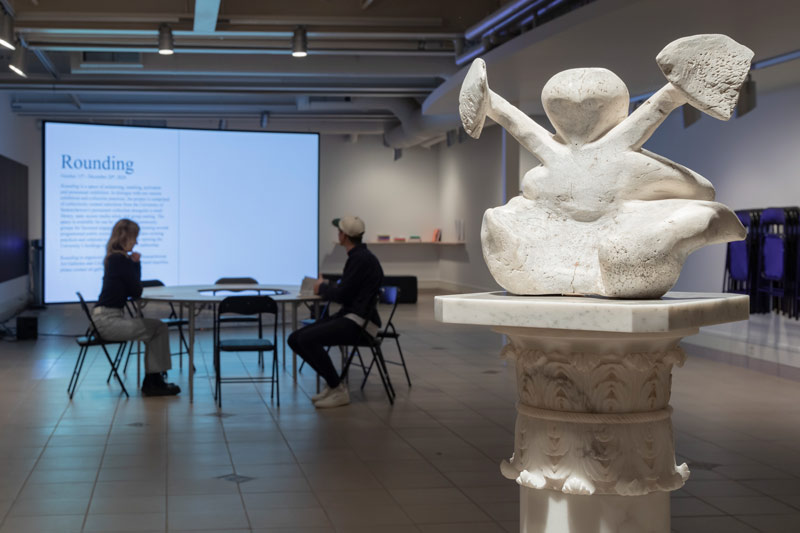
USask art exhibition invites visitors to make the gallery their own
A project called Rounding seeks to reveal the College Art Gallery as a place of collaboration and discourse
By Chris Putnam
The smell of Turkish food fills the University of Saskatchewan (USask) College Art Gallery as visitors grab a plate and settle in a circle on the floor. The occasional cry of a baby isn’t an interruption, but part of the atmosphere of this informal artist talk.
The Dec. 4 gathering in the basement of the Peter MacKinnon Building, a talk by local artist Muveddet Al-Katib, was an example of how the gallery space is being redefined with an exhibition called Rounding.
“It's about making very visible how we believe gallery spaces should operate: as not just sites of presentation, but sites of research and production, as sites of discourse, as sites of making, as sites of thinking through these objects in multiple ways,” said Cole Thompson, coordinating curator with the University Art Galleries and Collection.
Works of art are on display, but the gallery is mostly open space during the nine-week project. There’s a projector, a few tables, a microphone and flexible seating for up to 40 people.
All of it, said Thompson, represents “an open invitation.” Anyone is welcome to use the space to learn, think or engage as they see fit.
Since Rounding opened on Oct. 11, the gallery has hosted lectures, presentations, social events and meetings organized by groups from the university and the wider community. Instructors from multiple USask departments and disciplines have taught classes or held art viewings in the space. With final exams underway, students might find it an energizing place to study alone or in a group.
800jpg
jpg
jpg

“The name Rounding refers to a move away from Modernist and rationalist promotion of hyper-individualism and linearity characterized by a love of right angles. In our act of rounding, we aspire to anti-colonial engagement with the material culture of our institution and all of its invisible architectures,” said University Art Galleries and Collection director jake moore, who helped initiate the collaborative project along with Thompson.
There is no need to book ahead before using the space, but those who connect in advance with the University Art Galleries and Collection in the College of Arts and Science can get extra support such as having relevant works of art pulled from the collection and displayed during an event.
A goal of Rounding is to make the galleries and the university art collection more accessible to a diverse audience and the broader public. Instead of staff curators selecting artwork to display during the exhibition, artists and practitioners from beyond the USask campus were invited to choose works from the collection and submit responses to be displayed alongside the art.
Artists Tarralik Duffy of Salliq (Coral Harbour), Nunavut, and Audie Murray of Regina submitted selections and responses for the exhibition. moore was also a contributor.
“We don't want to just have these objects (from the collection) safeguarded and kept from the public,” said Thompson. “This has been a way to reach out to authors and voices from the community and have them creating the narratives and telling the stories around these objects.”
800jpg

Murray, whose solo exhibition Pawatamihkis running concurrently at the Kenderdine Art Gallery, called Rounding “such an interesting use of space.”
“It's kind of in flux and is also community-orientated, and it's nice to have that sort of a call-and-response grounding aspect to a space in the university.”
Murray gave an artist talk in the Rounding space in November.
“It was really nice,” she said. “It was a really comfortable setting. The space was set up in a way where I didn't, as an artist, necessarily feel like I was like talking or presenting at a group of people.”
Rounding runs until Dec. 13, but plans are already underway for it to continue. A second version of the project is scheduled for the Kenderdine Art Gallery in the Agriculture Building from January to April.
“Making clear that galleries are research sites, laboratories and social exchange spaces has been my goal since I started my position five years ago. The response from campus and community groups has been so positive that we know this is the right direction and will continue to bring in more Rounding programming,” said moore.


